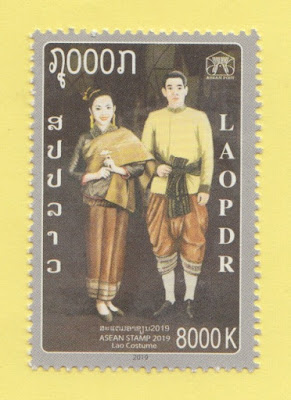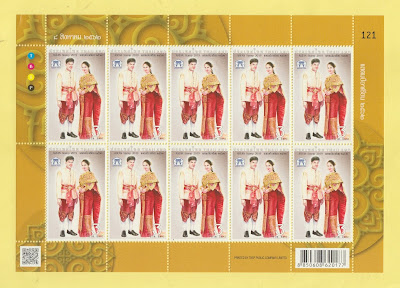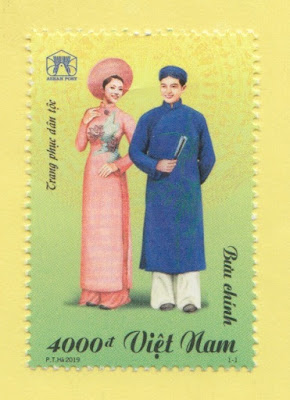
Technical Details:
Issue Date: 16 March 2017
Designer: Orsat Franković, designer from Zagreb
Illustrator: Photographs of Zlarin, Konavle, Istria: Ivo Pervan, photographer from Split,
Photographs of Podravina: DIF archives, Koprivnički Ivanec
Printer: AKD d.o.o., Zagreb
Process: Multicolour Offset
Size: 29.82 x 35.50 mm
Values: 3.00 HRK; 4.60 HRK; 5.00 HRK; 6.50 HRK
About Croatian Ethnographic Heritage 2017
Zlarin
Zlarin is a small island in the Šibenik archipelago. It is also called the “coral island“ due to the development of harvesting and processing of white and red corals that began in the 15th century. Even though small in size, the island bears significance because of its historical monuments. One of the more important ones is the parish register of the brotherhood of people in the Church of Our Lady of Rašelj written in the Chakavian dialect in 1456. In the 70s, older women on Zlarin dressed as documented in photos from the beginning of the 20th century. The basic attire consisted of a long linen shirt, the garments worn on top were dark blue or black vests with a red trim and long pleated skirts made of a brown or black wool fabric often with red bands just above the hem. The skirts were tightened on the chest and lengthened into shoulder straps made of red ribbons turning them into typical bell-shaped Mediterranean skirts with straps. The pleats were secured around the waist with colourful wool belts where the women would tuck their handkerchiefs. Married women wore white scarfs on their heads, while girls wore braids wrapped around their heads with red ribbons. The life on the Croatian islands and in the Adriatic region was humble, but it has kept up with the fashion trends from the earliest times because of trading and maritime commerce. This has also been manifested in jewellery. Young women and girls adorned themselves with gold and silver jewellery with semi-precious and precious stones. The jewellery was made by skilled domestic and foreign craftsmen using the old techniques of casting, refining, filigreeing, granulating and inserting. Due to its value, jewellery has been passed from generation to generation within the immediate and extended family. The most popular pieces were earrings of various shapes, pieces worn on the neck and chest consisting of shorter or longer gold or coral necklaces with pendants, as well as embellished broches and pins typically used to close the shirts on the chest area.
Podravina - Koprivnički Ivanec
Podravina is a geographical and historic Croatian region located in the lowlands and bounded by the river Drava, the hills of Bilogora and the extension of the Kalnik Mountain. Ethnologically, Podravina is known for its specific folklore (music and dance), national costumes and beliefs, as well as naive style paintings. In the village of Koprivnički Ivanec, not too far from Koprivnica, the local community nurtures the so-called Ivanec embroidery as its special identity characteristic. The embroidery adorns visible sections of national costumes worn by women, such as sleeves on shirts called “opleće” or “pleček”, and “poculica” hats. In the past, embroidery could be seen on handkerchiefs as well. This type of embroidery is created with a needle and a coloured thread using several techniques. Its characterised by various floral motifs from the nature (tulip, rose, daisy, lily of the valley, clover, oak leaf), and especially by motifs such as old clocks and hearts that are combined in various arrangements and colours of other elements of the embroidery. Dark to light shades of red colour dominate the embroidery, followed by green, blue, purple, white and black. The motif and the colour selection depend on the age of the person who wears it and the purpose of the item. Therefore, older women wear garments with humble dark colour embroidery, and younger women and girls wear garments with exuberant light colour embroidery. What makes the Ivanec embroidery special is the fact that it is directly stitched into the fabric without drawings. Since the Ivanec embroidery features a large number of decorative motifs, it is used to embellish table linens (tablecloths and napkins), but it has been also transferred onto ceramic dishes as a decorative pattern. Today, in addition to making replicas of national costumes, it is also used to embellish modern clothing and various other items. In light of its significance, in 2011 the art of Ivanec embroidery was listed in the register of intangible cultural heritage of the Republic of Croatia.
Konavle
The region of Konavle is located south-east of Dubrovnik in the most southern part of continental Croatia. Despite tourism and lifestyle changes in the 20th century, the women of Konavle have managed to preserve and continue to wear national costumes that speak of the extensive history, culture and economy of this region through their simplicity, beauty and elegance. The basic attire for women consists of long linen or cotton shirts in the shape of a simple tunic with sleeves. Embroidery is applied around the neck, on the chest and along the sleeve hem. The embroidery embellishment is the most exuberant and most visible on the bust area ending with yellow silk tufts. The beauty of the embroidery from Konavle was recognized at the end of the 19th century. Teachers, Ms. Paulina Bogdan Bijelić and Ms. Jelka Miš who managed an association and embroidery school in Cavtat during the period from 1922 to 1946, investigated and gathered patterns and taught women how to do embroidery. The women who do the Konavle type of embroidery show their skills and mathematical precision when counting surface threads in the process of creating embellishments that resemble weaving. The embroidery is made from the surface of the fabric by pulling a stitching needle with homemade wool, silk or factory-made cotton threads of various colours. This type of stitching produces geometric motif of numerous versions with various names. The women of Konavle used the embroidery to emphasize their social, wealth and marital status on their busts. For decades, the Konavle embroidery has been applied to modern items and souvenirs (tablecloths, purses, dresses, mats, pillowcases, shopping bags), and during the recent years, the embroidery motifs have been transferred to ceramics and glass. The Konavle embroidery has deep identity roots in the community and is made by women of Konavle of all generations, even by those who live in other parts of Croatia or in the diaspora. In light of its significance, the art of embroidery was listed in the register of intangible cultural heritage of the Republic of Croatia.
Istria
Istria is the largest peninsula on the Croatian side of the Adriatic Sea. It is positioned close to the heart of Europe and it represents a bridge that connects mid-European continental area with the Mediterranean. This has been manifested in its rich and diverse ethnographic heritage. Two-part singing and playing in the Istrian scale, a characteristic musical phenomenon, was added to UNESCO's representative list of intangible cultural heritage. Fabric handwork in Istria has inherited mid-European, Mediterranean and Slavic traditions. In Istria, women handled the tasks of processing and preparing raw fabric materials, while men were in charge of weaving. Weavers were greatly respected people who took up weaving alongside their primary agricultural tasks. The skill of weaving was passed from father to son or from weavers to their apprentices. Weavers from the area around Žminj, Kringa and Zrenj were renowned for the quality of their weaving. They worked on large horizontal looms and they weaved flax, hemp and wool fabrics of natural white and brown colour with the help of two or four heddles. The weaving production had begun to disappear at the end of the 19th century, and it almost completely disappeared during the 1960s. Today, weaving is done by older persons for the purpose of presentations and workshops. There are two basic types of outerwear patterns found on Istrian women’s garments where centuries have accumulated: dresses tailored using pegs (“modrne klinarice”) and dresses that consist of vests and pleated skirts (“modrne na skas”). Both types are made from domestic hemp, wool or purchased fabrics. Pleated skirts are adorned with simple embellishments above the hemline with narrow or broad trim stripes of various colours. They have many pleats giving the garments elegance and special effects in dance movements.
Tihana Petrović Leš, PhD
































